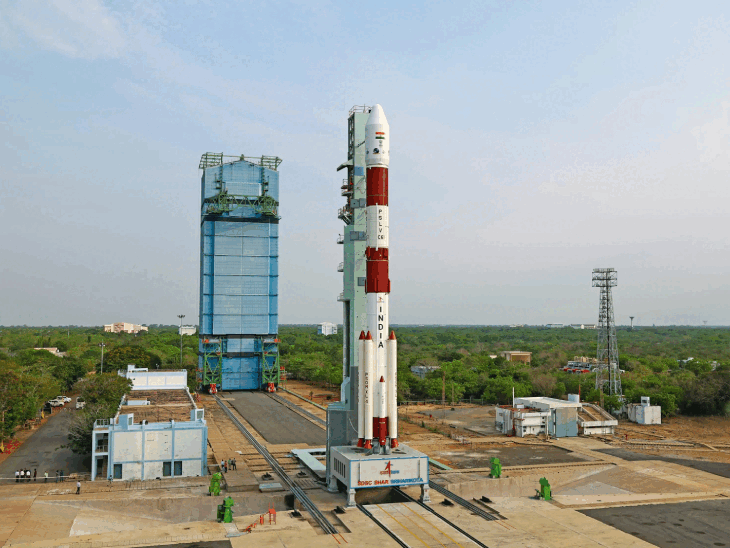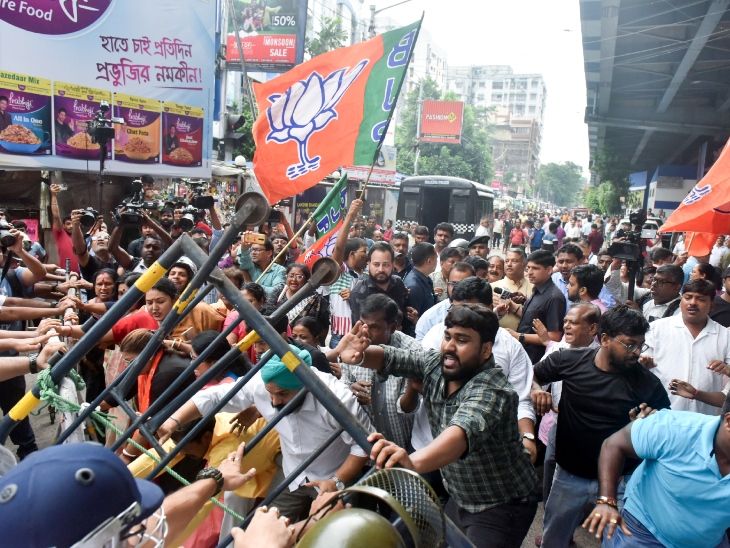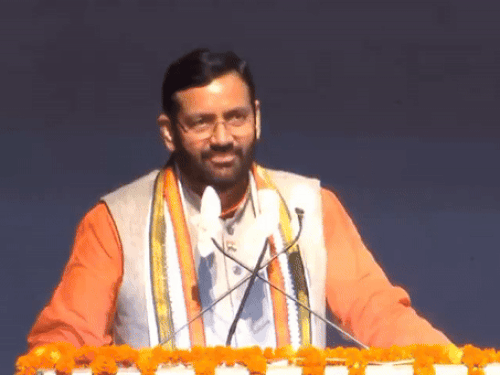Sriharikota19 minutes ago
- Copy link

Indian Space Research Organization i.e. ISRO’s PSLV-C61 mission failed due to technical fault. In this mission, the EOS-09 Earth Observation Satellite was to be installed in a 524 km sun-cinchronus Polar Orbit. This was ISRO’s 101st launch mission. ISRO has formed a committee to find out the reasons for mission failure.

The PSLV-C61 launched on May 18 at 5:59 am from the Satish Dhawan Space Center in Sriharikota.
Before proceeding in the news, know about these technical words, which will make it easier to understand the whole news:
Polar Satellite Launch Vehicle: PSLV is a reliable rocket of ISRO, which launchs satellites in the Earth’s orbit, especially in the polar and sun-cinnus orbit (600–800 km). It is a launch vehicle with four stages (solid and liquid engines), which is used for remote sensing, communication and scientific missions.

Ground-Lit Strap-on Motors: There are additional booster engines of rockets, which ignite on the ground at the time of launch give the rocket an early thrust. They are associated with the main core of rockets like PSLV and give the necessary strength for lift-off. They separate when the propellent is over.
Onboard Instrumentation: These are sensors and equipment on rockets or satellites, such as excelrome, gyroscopa and interchangeable measurement unit (IMU), which measure speed, direction, height and other data in real-time. This data is sent to the ground station via telemetry, so that the mission status and the tragects can be monitored.
Telemetry: This is a technique in which data (eg speed, height, pressure, orientation) from rocket or satellite is sent to the ground station in real-time via radio signal. This data is necessary for monitoring and analysis of the mission.

The top line is telling the speed of the rocket. At the same time, the bottom line tells Ochai. In the T and I written at the bottom, T means trekking and I mean less means instruments.
Ground-based tracking: That is the process in which the position, speed and direction of the rocket or satellite using radar, antenna and ground stations are tracked into real-time. It is different from onboard instrumentation data and helps monitor the mission.
Close Loop Guidance: There is an automatic control system, in which the rocket’s onboard computer collects the tragects, thrust and orientation by analyzing the computer real-time data (eg sensor, imu, gNSS). This ensures that rockets arrived in their prescribed class accurately without intervention of ground control.
Mission starts: everything is normal
The launch of PSLV-C61 was made today i.e. on May 18 at 5:59 am from the Satish Dhawan Space Center of Sriharikota. In the early stages of the launch, everything was going on according to the plan. The performance of countdown, first stage ignition, lift-off and solid motors was normal.
The four ground-lit strap-on motors and the Central Core acted exactly the same way. After this, the ignition of the air-lit strap-on motors was also on time, and the rocket was moving forward at its scheduled trage. ISRO’s announcements repeatedly stated that first stage performance is normal.
Second stage also performed completely normal. It uses liquid growth engine. During this time onboard instrumentation and ground-based tracking data were completely matching with each other. Real-time data and animation were also according to curves, showing that the rocket was achieving its speed and height.

In the early stages of the launch, everything was going on according to the plan.
Where did the lapse: Third stage disturbances
The problem in the mission began when the rocket reached its third stage (PS3), which is a solid motor. According to ISRO, the ignition of the third stage was normally at 262.9 seconds. Everything was visible in the initial data. During this period, the height of the rocket was 344.9 km, the speed 5.62 km/second and the range was 888.4 km. However, after 376.8 seconds, the telemetry data appeared to be a mess.
Two types of data are analyzed at ISRO’s ground stations:
- Onboard instrumentation data, which meets the rocket’s interchangeable measurement unit (IMU), acceters and gyroscopes.
- Ground-based tracking data, which tracks the position of the rocket through radar and antenna system.
Both these data sources are shown in the graph, where the green line shows onboard instrumentation and yellow line tracking data.
In the early stages of the mission, the green and yellow lines were completely overlap, showing that the performance of the rocket was fine. But during the third stage, at about 376.8 seconds, the two lines began to separate.
The Green Line, which showed data from onboard sensors, featured zigzag patterns and developments, while the yellow line, which showed tracking data, stated a different situation. This development was an indication that the data between the rocket’s onboard system and ground tracking was not the same.

Here the Green Line reflects onboard instrumentation and yellow line tracking data. If everything in the mission is according to the plan, then both line runs overlap. Initially, the line was running overlap here, but after the third stage, the two lines separated which reflects the disturbances.
Potential causes: inequality in thrust or data transmission disturbances
The rocket was in close loop guidance mode during the third stage, in which the onboard computer takes the decision freely based on real-time data. In this mode, the Inspector Measurement Unit, Global Navigation Satellite System and other sensors control the orientation, thrust, and trageteles of rockets. But in this mission, the data sent by the onboard system was not matching the tracking data.
Analysts believe that there can be many possible reasons for this development:
- Censor Felier: Onboard sensors, such as IMU or acceters, may have produced wrong data due to malfunction.
- Algorithm error: The algorithms used in the close loop guidance system may cause an error in miscalctions or data processing.
- Thrust abnormality: Third stage solid motors may cause unexpected pressure decrease or nozzle problems, due to which the expected thrust did not arise.
- Data Transmission Error: Any disturbances in the telemetry system, due to which the onboard data did not reach the ground station correctly.
After this development, the rocket began to adjust its tragects incorrectly, due to which it could not reach its scheduled class. The fourth phase (PS4) was also ignited, but by then the success of the mission was not possible. The final mission had to be canceled in the middle, and the rocket and satellite were destroyed.
ISRO Chairman: Felier Analysis Committee will detect reasons
ISRO Chairman V. Narayanan said that after the third stage, the mission was seen in the mission, due to which the EOS-09 satellite could not be installed in orbit. He said, “We have formed a Felier Analysis Committee to find out the causes of this failure. The committee will do a detailed analysis of telemetry data, onboard system logs and ground tracking data. By studying millions of bits data, we will find out accurate reasons and improve for future missions.”
ISRO has taken a lesson from failures before. For example, after the failure of the EOS-03 mission in 2021, the problem of pressure in the cryogenic stage tank was detected, and improvements were made at the base. This time too, ISRO’s team will make a thorough analysis of preparations, launch process and all data logs of onboard systems before the launch.

ISRO Cherman said- During the third phase, the chamber pressure of the motor case had declined due to which the mission could not be completed.
Satellite was to be used in agriculture, forestry and disaster management
The EOS-09 weighing 1,696.24 kg sent with PSLV rocket was an important part of the Satellite ISRO’s meaning observation program. Its purpose was to provide high-resolution imagery for applications in agriculture, forestry and disaster management.
Question on the reliability of PSLV?
PSLV (Polar Satellite Launch Vehicle) has been the most trusted rocket of ISRO, known as “workheors”. Most of its more than 60 missions have been successful, and this rocket has been able to establish satellites of global customers along with India. However, in recent years, some failures, such as the problem of tragetized manuvar in NBS missions and now the failure of PSLV-C61, have introduced new challenges to ISRO.




